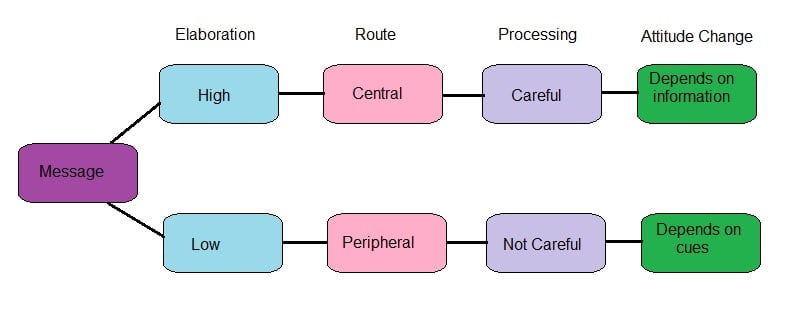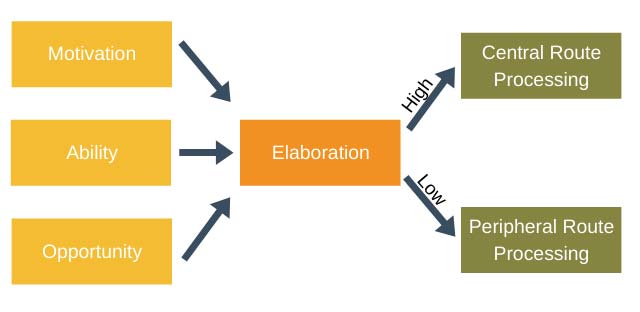The Central Route to Persuasion involves deeply processing the content of a message, focusing on its logic and the quality of its arguments. It requires greater cognitive effort and results in more durable attitude change when the message is compelling.
Persuasion is the term used to describe the many types of influences that are available when trying to influence an individual or a group of people.
As humans, we do not have the capacity to process all the information that we are bombarded with through our senses.
Only the relevant events grab our attention, while irrelevant ones are either neglected or processed with less effort. Thus, when trying to persuade others, different routes of persuasion can be used to increase the likelihood of attitude change.
The Elaboration Likelihood Model of Persuasion
A popular model of persuasion is called the Elaboration Likelihood Model of persuasion, developed by Petty and Cacioppo (1986).
This model considers the variables of the attitude change approach and describes that there is a central route to persuasion.
Earlier models of persuasion assumed that humans processed information like computers which is criticized as being too simplistic. The Elaboration Likelihood Model is more descriptive in that it considers what makes a message strong and how motivated people are to be influenced.
The central route is used when information is processed by the audience in a thorough way.
The researchers propose that the central route gets activated when there is a motivation to understand the information, and there is the ability to process this information.
The central route to persuasion is thought to be a direct route that focuses on the quality of the information presented to the audience.
Petty and Cacioppo explained that for the central route to be effective in changing attitudes, thoughts, and behaviors, the argument or message must be strong and, if successful, will result in lasting attitude change.
What are the two routes of persuasion?
The Elaboration Likelihood Model of persuasion considers the variables of the attitude change approach.
These are: the features of the source of the persuasive message, the contents of the message, and the characteristics of the audience. These will all determine whether attitude change will occur.
According to the Elaboration Likelihood model, there are two main routes that play a role in delivering a persuasive message: the central and peripheral routes.

Central route
The central route to persuasion is a logic-driven approach, using data and facts to convince people of an argument or product’s worthiness. Persuasion that uses this approach assumes that the target audience is motivated and analytical when presented with the message.
The central route requires the audience to put effort into processing what is being presented to them and evaluate the message. A persuasion of this route may use statistics as evidence to persuade the audience to understand that their product is trustworthy.
The audience is active in this route and is likely to believe what they are being shown or told.
Because of the techniques used in the central route, the persuasion results in a lasting change in attitude.
Peripheral route
The peripheral route to persuasion is an indirect route that uses peripheral cues to associate positivity with the message.
Instead of focusing on the facts and a product’s quality, the peripheral route relies on association with positive characteristics such as positive emotions. For instance, the peripheral route may use attractive speakers or celebrities to endorse a product.
This route does not require much effort or information processing of the target audience. Rather, the audience is usually passive, unmotivated, and not analytical.
Sometimes this route may not even be noticed by the target audience, such as the strategy of product placement.
Although the peripheral route promotes positivity towards the message or product, attitude and behavioral change are often temporary, so there are not usually long-lasting effects when using this type of persuasion.
What are the key features of the central route to persuasion?
In a persuasive message that uses the central route to persuasion, there are four key features:

Persuasive communication
The message given is one-sided and shows the benefits of what is being presented. Persuasion is more likely to occur if the arguments are compelling.
Motivation to process
The audience is not passive; rather, they are willing to actively change their attitudes and behavior according to the content of the message. This is more likely to happen when a message is directly related to the person involved.
Ability to process
Individuals who are not paying attention or are distracted are not likely to be influenced by a persuasive argument. An audience is likely to be influenced by the central route to persuasion if they are actively paying attention.
Nature of arguments
In a persuasive central route argument, there needs to be a strong and convincing message that can have the potential to change someone’s behavior and attitudes. Attitudes that are persuaded by the central route are likely to have long-lasting effects and are less resistant to change.
Examples of central route persuasion
If you want to purchase a new car but you are not an expert on the types and models, the central route to persuasion can be used to influence what car you want to buy.
If you see a persuasive argument, such as a commercial that includes information about the features of the car, presented in a way that makes the car seem as if it is the best or most reliable, you may be more likely to be interested in making a purchase.
In comparison, the peripheral route may try to persuade an audience by showing how attractive the car looks.
If someone wants to sell a new video game, the central route to persuasion can be used to persuade people who are already interested in video games, especially if the game being pitched is a genre of the game an individual is interested in.
They may be more likely to be interested in learning about the content of the game as well as how it compares to other games, through the central route. In comparison, someone who is not into video games may only be convinced by how impressive the game looks (peripheral route).
What are the benefits of the central route to persuasion?
The biggest benefit to using the central route to persuasion is the long-lasting effect that can come with it.
Someone influenced by the central route is likely to have a lasting change in their attitude.
This attitude change has what is known as high ‘temporal persistence,’ meaning it is likely to stay effective over time.
It is generally understood that attitudes remain relatively stable, so when someone is persuaded through the central route, they may be less influenced by any counterarguments.
How to use the central route to persuasion
The central route to persuasion often relies on reasoning and information processing by the consumers.
A persuasive message can be designed using some of the key tools for the central route, such as using facts, logical arguments, statistics, and empirical results.
Often, a persuasive argument can aim to teach the audience about something using facts and statistics. For instance, a persuasive argument for a drink may display the product’s calories directly compared to a similar drink with a higher calorie count.
The audience can then visibly see the facts in front of them and conclude that one product must be better than the other.
Empirical research can be carried out on some products and presented to the audience to increase the likelihood that they will be persuaded.
For instance, a commercial for a skincare product may include information about research that was conducted into the product’s effectiveness.
They may provide their research findings by including that a certain percentage of participants noticed a difference in their skin after using the product.
Including informational data in the persuasive message can strengthen the likelihood that the audience will be persuaded to change their attitude and behavior.
What are the differences between the central and peripheral routes to persuasion?
Below are some key differences between the central and the peripheral routes to persuasion:
-
Individuals who are influenced by the peripheral route are usually passive and unmotivated to think too much about the message being presented to them. Those who are influenced by the central route of persuasion are usually actively engaged in learning about the message presented to them and are analytical.
-
The peripheral route aims to make the message as positive and attractive as possible to obtain people’s attention. The central route is not so concerned with attractiveness but about presenting the facts and truth.
-
Attitude change from the peripheral route is likely to be temporary and subject to change when presented with a new argument. However, attitude changes from the central route are likely to show greater resistance to change and be a greater predictor of behavior.
-
The peripheral route to persuasion is more likely to be used on commercial adverts, whereas the central route is most often associated with informative pieces such as brochures.
-
There is high involvement processing in the central route compared to low-involvement processing in the peripheral route.
References
Cacioppo, J. T., Petty, R. E., Kao, C. F., & Rodriguez, R. (1986). Central and peripheral routes to persuasion: An individual difference perspective. Journal of personality and social psychology, 51(5), 1032.
Petty, R. E., & Cacioppo, J. T. (1986). The elaboration likelihood model of persuasion. In Communication and persuasion (pp. 1-24). Springer, New York, NY.
Petty, R. E., Kasmer, J. A., Haugtvedt, C. P., & Cacioppo, J. T. (1987). Source and message factors in persuasion: A reply to Stiff’s critique of the elaboration likelihood model.
Petty, R. E., Barden, J., & Wheeler, S. C. (2009). The elaboration likelihood model of persuasion: developing health promotions for sustained behavioral change.
Wagner, B. C., & Petty, R. E. (2011). The elaboration likelihood model of persuasion: Thoughtful and non-thoughtful social influence.

